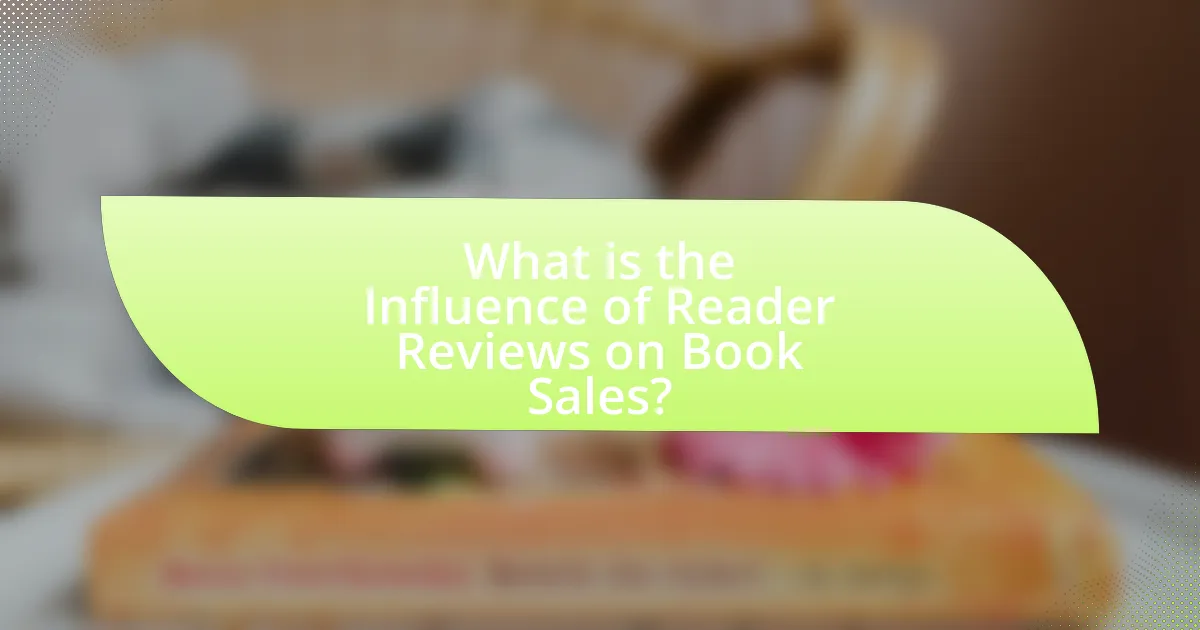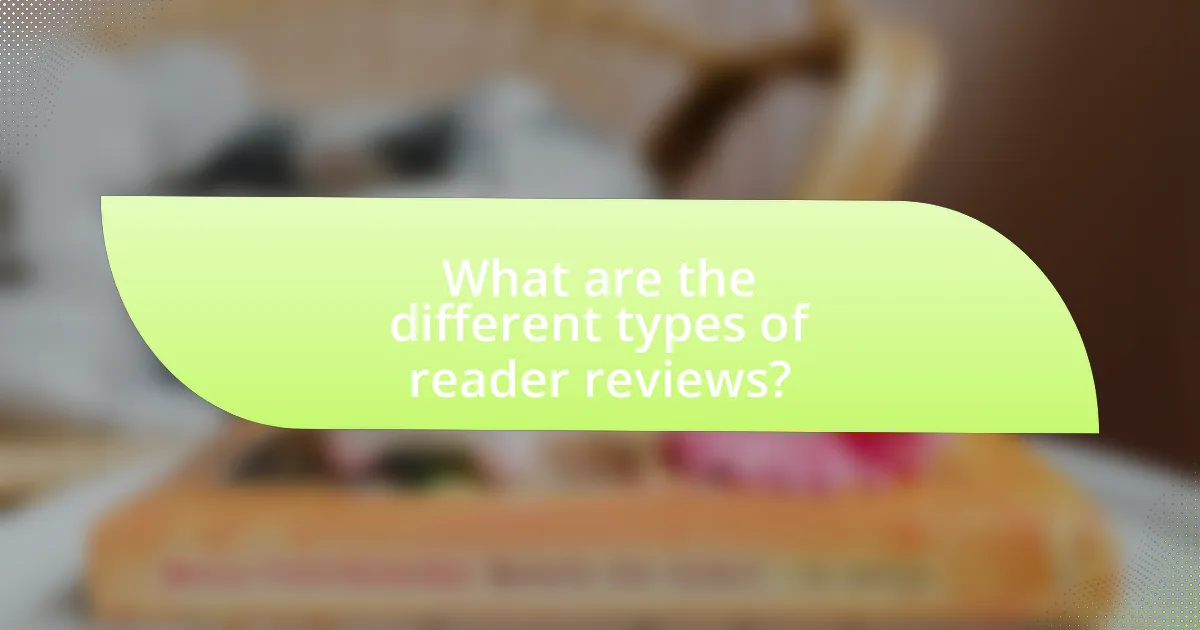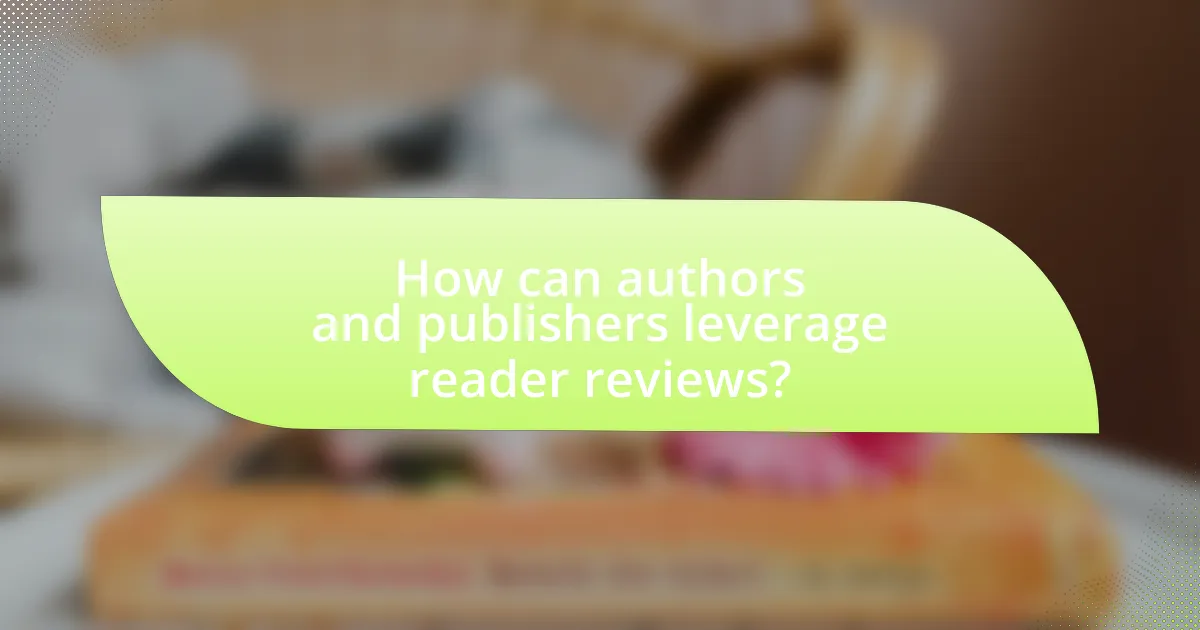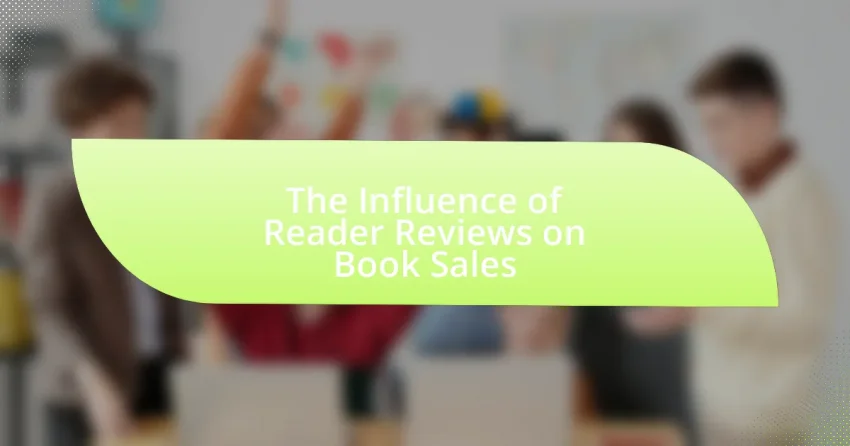The article examines the significant influence of reader reviews on book sales, highlighting how positive ratings and feedback can enhance consumer trust and purchasing decisions. Research indicates that higher ratings correlate with increased sales, with a one-star increase potentially leading to a 10-20% rise in sales. It explores the psychological factors affecting reader perceptions, the role of online platforms like Amazon and Goodreads in amplifying review visibility, and the differences in impact between positive and negative reviews. Additionally, the article discusses strategies for authors and publishers to leverage reader reviews effectively, including engaging with readers and utilizing feedback in marketing efforts.

What is the Influence of Reader Reviews on Book Sales?
Reader reviews significantly influence book sales by shaping potential buyers’ perceptions and decisions. Research indicates that books with higher ratings and positive reviews tend to sell better; for instance, a study published in the Journal of Marketing Research found that a one-star increase in ratings can lead to a 10-15% increase in sales. Additionally, reader reviews provide social proof, which enhances credibility and encourages purchases, as consumers often rely on the experiences of others when making buying decisions.
How do reader reviews impact consumer purchasing decisions?
Reader reviews significantly influence consumer purchasing decisions by shaping perceptions of a book’s quality and appeal. Research indicates that 79% of consumers trust online reviews as much as personal recommendations, highlighting their importance in the decision-making process. Positive reviews can enhance a book’s visibility and desirability, while negative reviews can deter potential buyers. Furthermore, a study published in the Journal of Marketing Research found that a one-star increase in a book’s rating can lead to a 5-10% increase in sales, demonstrating the direct correlation between reader reviews and purchasing behavior.
What psychological factors influence readers when they read reviews?
Psychological factors that influence readers when they read reviews include social proof, cognitive dissonance, and emotional engagement. Social proof occurs when readers rely on the opinions of others to validate their choices, often leading them to favor products or books with higher ratings and positive feedback. Cognitive dissonance arises when readers encounter reviews that conflict with their pre-existing beliefs or expectations, prompting them to reassess their views or seek additional information to resolve the inconsistency. Emotional engagement is significant as reviews that evoke strong feelings, whether positive or negative, can impact a reader’s perception and decision-making process. Research indicates that emotionally charged reviews are more likely to be remembered and influence purchasing behavior, as demonstrated in studies by Berger and Schwartz (2011) in “What Drives Immediate and Ongoing Word of Mouth?” published in the Journal of Marketing Research.
How do positive and negative reviews affect buyer behavior differently?
Positive reviews generally enhance buyer behavior by increasing trust and perceived value, while negative reviews tend to deter potential buyers by raising concerns about quality and satisfaction. Research indicates that 70% of consumers trust online reviews as much as personal recommendations, highlighting the significant impact of positive feedback on purchasing decisions. Conversely, a study published in the Journal of Consumer Research found that negative reviews can lead to a 22% decrease in sales, as they create doubt and fear of poor experiences. Thus, positive reviews foster confidence and encourage purchases, while negative reviews instill hesitation and reduce buyer interest.
What role do online platforms play in the visibility of reader reviews?
Online platforms significantly enhance the visibility of reader reviews by providing a centralized space where consumers can easily access and share feedback. These platforms, such as Amazon and Goodreads, aggregate reviews, making them readily available to potential buyers, which influences purchasing decisions. Research indicates that 79% of consumers trust online reviews as much as personal recommendations, highlighting the importance of visibility in shaping consumer behavior. Furthermore, the algorithms used by these platforms often prioritize reviews, ensuring that they appear prominently in search results, thereby increasing their reach and impact on book sales.
Which platforms are most influential in shaping book sales?
Amazon and Goodreads are the most influential platforms in shaping book sales. Amazon dominates the online book market, accounting for approximately 50% of all book sales in the United States, while Goodreads serves as a vital social networking site for readers, where user-generated reviews significantly impact purchasing decisions. Research indicates that books with higher ratings and more reviews on Goodreads tend to sell better, demonstrating the direct correlation between reader feedback and sales performance.
How does the algorithm of these platforms affect the prominence of reviews?
The algorithms of platforms significantly influence the prominence of reviews by determining which reviews are displayed prominently to users. These algorithms often prioritize reviews based on factors such as recency, helpfulness ratings, and user engagement, which can lead to certain reviews being more visible than others. For instance, a review that receives a high number of “helpful” votes may be ranked higher, making it more likely to be seen by potential buyers. Additionally, algorithms may favor reviews from verified purchasers or those that contain specific keywords, further shaping the visibility of feedback. This selective visibility can directly impact consumer perceptions and, consequently, book sales, as highlighted by research indicating that products with more prominent positive reviews tend to experience higher sales volumes.
Why are reader reviews considered a form of social proof?
Reader reviews are considered a form of social proof because they reflect the opinions and experiences of other consumers, influencing potential buyers’ perceptions and decisions. When individuals see positive feedback from fellow readers, it validates the quality and appeal of a book, making them more likely to purchase it. Research indicates that 79% of consumers trust online reviews as much as personal recommendations, highlighting the significant impact of reader reviews on consumer behavior. This trust stems from the idea that if many others have had a positive experience, new readers are more inclined to believe they will have a similar experience.
What is the relationship between social proof and consumer trust?
Social proof significantly enhances consumer trust by providing evidence that others have positively evaluated a product or service. When consumers observe that many others have purchased or endorsed a product, they are more likely to perceive it as trustworthy and reliable. Research indicates that 79% of consumers trust online reviews as much as personal recommendations, demonstrating the powerful impact of social proof on purchasing decisions. This correlation suggests that positive reader reviews can lead to increased consumer confidence, ultimately influencing book sales.
How do reader reviews compare to professional critiques in terms of influence?
Reader reviews generally have a more significant influence on consumer purchasing decisions compared to professional critiques. Research indicates that 79% of consumers trust online reviews as much as personal recommendations, highlighting the power of peer opinions in shaping buying behavior. In contrast, professional critiques, while respected, often reach a narrower audience and may not resonate as strongly with the average reader. A study published in the Journal of Marketing Research found that books with higher reader ratings on platforms like Goodreads tend to sell better than those with favorable professional reviews, demonstrating the direct impact of reader feedback on sales.

What are the different types of reader reviews?
Reader reviews can be categorized into several types, including star ratings, written reviews, video reviews, and social media posts. Star ratings provide a quick assessment of a book’s quality, typically on a scale from one to five stars, allowing readers to gauge overall satisfaction at a glance. Written reviews offer detailed opinions and critiques, often discussing plot, character development, and writing style, which can influence potential buyers’ decisions. Video reviews, commonly found on platforms like YouTube, combine visual elements with personal commentary, appealing to viewers who prefer multimedia content. Social media posts, including tweets and Instagram stories, allow readers to share their thoughts in a more informal and immediate manner, often reaching a wider audience quickly. Each type of review plays a significant role in shaping public perception and can directly impact book sales by influencing potential readers’ choices.
How do star ratings influence book sales?
Star ratings significantly influence book sales by affecting consumer perception and decision-making. Research indicates that higher star ratings correlate with increased sales, as consumers often rely on these ratings as a heuristic for quality. For instance, a study published in the Journal of Marketing Research found that a one-star increase in ratings can lead to a 10-20% increase in sales. This demonstrates that star ratings serve as a critical factor in the purchasing process, guiding potential buyers toward books perceived as more favorable based on aggregated reader feedback.
What is the significance of a 5-star rating versus a 4-star rating?
A 5-star rating signifies a higher level of satisfaction and quality compared to a 4-star rating, indicating that readers perceive the book as exceptional rather than merely good. Research shows that books with a 5-star rating tend to attract more attention and sales, as consumers often associate higher ratings with better content and value. For instance, a study published in the Journal of Marketing Research found that products with higher ratings can experience a significant increase in sales, with a 5-star rating leading to a 20% increase in purchase likelihood compared to a 4-star rating. This demonstrates that the distinction between a 5-star and a 4-star rating can substantially influence consumer behavior and ultimately impact book sales.
How do average ratings affect consumer perception of a book?
Average ratings significantly influence consumer perception of a book by serving as a quick reference for quality assessment. When potential readers encounter a book with high average ratings, they are more likely to perceive it as credible and worth their time, often associating higher ratings with better content and storytelling. Research indicates that books with an average rating of 4 stars or higher tend to attract more readers, as consumers often rely on these ratings to make purchasing decisions. For instance, a study published in the Journal of Marketing Research found that a one-star increase in average rating can lead to a 10-20% increase in sales, demonstrating the direct correlation between ratings and consumer behavior.
What are the characteristics of effective reader reviews?
Effective reader reviews are characterized by clarity, specificity, and honesty. Clarity ensures that the review is easily understandable, allowing potential readers to grasp the reviewer’s perspective without confusion. Specificity involves detailing particular aspects of the book, such as plot points, character development, and writing style, which helps readers make informed decisions. Honesty reflects the reviewer’s genuine opinion, whether positive or negative, fostering trust among potential readers. Research indicates that reviews with these characteristics significantly influence purchasing decisions, as they provide valuable insights that resonate with the target audience.
What elements make a review persuasive to potential buyers?
Persuasive reviews for potential buyers typically include authenticity, detailed descriptions, emotional appeal, and social proof. Authenticity is established through genuine experiences and specific anecdotes that resonate with readers, making the review relatable. Detailed descriptions of the product’s features and benefits help buyers visualize its value, while emotional appeal connects with the reader’s feelings, enhancing their desire to purchase. Social proof, such as ratings and testimonials from other users, reinforces credibility and trust, influencing the buyer’s decision. Research indicates that reviews with these elements significantly increase conversion rates, as they address buyer concerns and enhance perceived value.
How does the length and detail of a review impact its effectiveness?
The length and detail of a review significantly impact its effectiveness by influencing reader engagement and perceived credibility. Longer, detailed reviews provide comprehensive insights that help potential buyers make informed decisions, as they often include specific examples and thorough evaluations of the content. Research indicates that reviews with more than 200 words tend to receive higher engagement rates, as they offer depth that shorter reviews lack. Additionally, detailed reviews are perceived as more trustworthy; a study published in the Journal of Consumer Research found that consumers are more likely to trust reviews that provide extensive information, leading to increased sales conversions. Thus, the effectiveness of a review is directly correlated with its length and detail, as these factors enhance clarity and trustworthiness for potential readers.

How can authors and publishers leverage reader reviews?
Authors and publishers can leverage reader reviews by using them as a marketing tool to enhance visibility and credibility. Positive reviews can be prominently featured in promotional materials and on book covers, which can attract potential readers. According to a study by the Nielsen Company, 70% of consumers trust online reviews as much as personal recommendations, indicating that reader reviews significantly influence purchasing decisions. Additionally, authors and publishers can engage with readers by responding to reviews, fostering a community that encourages further discussion and sharing of the book, ultimately driving sales.
What strategies can authors use to encourage more reviews?
Authors can encourage more reviews by actively engaging with their readers and creating a clear call to action. Engaging with readers through social media, newsletters, and author events fosters a community where readers feel valued and more inclined to share their thoughts. Additionally, authors can include a polite request for reviews at the end of their books, making it easy for readers to understand how to leave feedback. Research indicates that books with a higher number of reviews tend to have increased visibility and sales, as potential buyers often rely on reviews to make purchasing decisions. Therefore, implementing these strategies can significantly enhance the likelihood of receiving more reviews.
How can social media be utilized to gather reader feedback?
Social media can be utilized to gather reader feedback by creating interactive posts that encourage audience engagement, such as polls, questions, and comment prompts. These methods allow authors and publishers to directly solicit opinions and insights from readers, facilitating real-time feedback. For instance, a survey conducted by the Pew Research Center in 2021 found that 69% of adults in the U.S. use social media, making it a valuable platform for reaching a broad audience. By analyzing comments and reactions on platforms like Twitter, Facebook, and Instagram, authors can gain qualitative insights into reader preferences and sentiments, which can directly influence book sales and marketing strategies.
What role do book giveaways play in increasing review counts?
Book giveaways significantly increase review counts by incentivizing readers to engage with the book. When authors or publishers offer free copies, they attract a larger audience, which often leads to more readers sharing their thoughts and experiences through reviews. Research indicates that books with giveaways can see a 20-30% increase in reviews compared to those without such promotions. This increase is primarily due to the heightened visibility and accessibility of the book, encouraging readers to provide feedback in exchange for the opportunity to receive a free copy.
What are the best practices for responding to reader reviews?
The best practices for responding to reader reviews include acknowledging the feedback, personalizing responses, and maintaining professionalism. Acknowledging feedback demonstrates that the author values reader opinions, which can enhance reader engagement and loyalty. Personalizing responses, such as addressing the reviewer by name and referencing specific points from their review, fosters a connection and shows genuine interest. Maintaining professionalism, even in the face of negative reviews, reflects positively on the author and can mitigate potential damage to their reputation. Research indicates that authors who actively engage with reviews can see an increase in book sales, as positive interactions can encourage potential readers to make a purchase.
How should authors handle negative reviews constructively?
Authors should handle negative reviews constructively by analyzing the feedback for actionable insights. This approach allows authors to identify specific areas for improvement in their writing or storytelling. For instance, if multiple reviewers mention pacing issues, the author can focus on enhancing the narrative flow in future works. Research indicates that constructive engagement with feedback can lead to improved writing quality and increased reader satisfaction, ultimately influencing book sales positively. By addressing valid criticisms, authors not only enhance their skills but also demonstrate to readers that they value their opinions, fostering a loyal readership.
What are the benefits of engaging with readers through reviews?
Engaging with readers through reviews enhances author-reader relationships and boosts book sales. This interaction fosters a sense of community, encouraging readers to feel valued and heard, which can lead to increased loyalty and repeat purchases. Additionally, responding to reviews can improve an author’s visibility and credibility, as potential readers often consider the engagement level when deciding to buy a book. Research indicates that books with higher engagement in reviews tend to have better sales performance, as seen in a study by the University of Pennsylvania, which found that author responses to reviews can increase sales by up to 20%.
What practical tips can authors implement to maximize the impact of reader reviews on sales?
Authors can maximize the impact of reader reviews on sales by actively encouraging readers to leave reviews, responding to reviews, and utilizing reviews in marketing strategies. Actively requesting reviews from readers, especially after a purchase or during a newsletter interaction, increases the likelihood of receiving feedback. Research indicates that books with more reviews tend to have higher sales, as potential buyers often rely on social proof when making purchasing decisions. Responding to reviews, both positive and negative, fosters a sense of community and engagement, which can enhance reader loyalty and encourage further purchases. Additionally, incorporating positive reviews into promotional materials, such as social media posts or book covers, can attract new readers by showcasing the book’s credibility and appeal.
